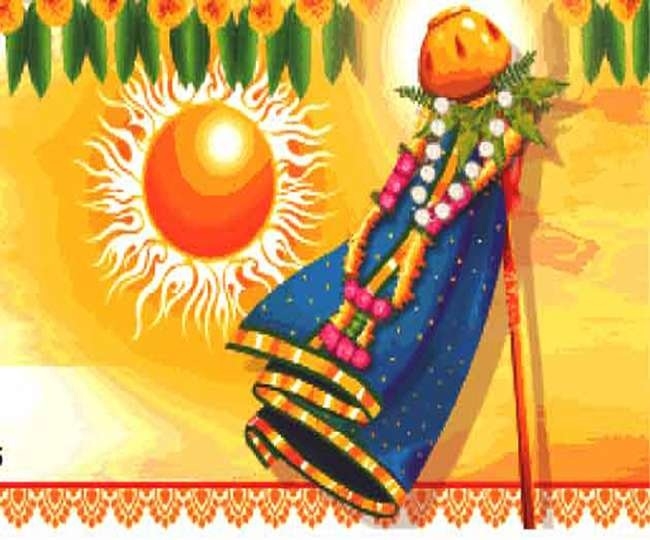Gudhi Padwa: Beginning of Sharvari/Pramadhi Nama Samvatsar
| Date :25-Mar-2020 |

By Rajendra Diwe :
Chaitra Ghatasthapana today
Ghatasthapana Muhurat - 06.13 am to 07.16 am
Duration - 01 Hour 03 Mins
Ghatasthapana Muhurta falls on Pratipada Tithi
Ghatasthapana Muhurta falls during Dvi-Svabhava Meena Lagna
Pratipada Tithi Begins - 02.57 pm on March 24
Pratipada Tithi Ends - 05.26 pm on March 25
Meena Lagna Begins - 06.13 am on March 25
Meena Lagna Ends - 07.16 am on March 25
ACCORDING to Vedic Astrology, first day of Chaitra month is the first day of New Year of entire universe. Chaitra Shuddha Pratipada is celebrated across the country as the first day of New Year as per Hindu traditions. The New Year is termed as Nav Samvatsar or Nav Samvat because according to Hindu scripture Brahma Purana, the universe was created on this day by God Bramha. Spring season also starts from this day, which is a symbol of new construction of nature. The country has different calendars as per different astronomical calculations.
On the basis of these calculations, the name of the Samvatsar has been defined such as Shak Samvat, Vikram Samvat, Kali Yuga Samvat etc. Shak Samvat is the national calendar of India, Vikram Samvat is also widely recognised. Each Hindu calendar is in a 60-year cycle and each year has a name that reflects its attributes. The new Samvatsar, which starts on March 25 this year, is named Sharvari and the year 1942 according to Shaka Samvat, and according to Vikram Samvat, its name is Pramathi or Pramadhi and year is 2077. The first day of new samvatsar is celebrated as Gudhi Padwa or Samvatsar Padvo by Maharashtrians and Konkanis. On the day new Samvatsara, which is cycle of sixty years, starts. All sixty Samvatsara are identified by unique name. Gudhi Padwa is celebrated as Ugadi by the people of Karnataka and Andhra Pradesh. Gudhi Padwa is Marathi New Year according to Luni-Solar calendar. Luni-Solar calendars consider the position of the Moon and the position of the Sun to divide the year into months and days.
The counter-part of Luni-Solar calendar is Solar calendar which considers only position of the Sun to divide the year into months and days. Because of that Hindu New Year is celebrated twice in the year with different names and at two different times of the year. The Hindu New Year based on Solar calendar is known as Puthandu in Tamil Nadu, Bihu in Assam, Baisakhi in Punjab, Pana Sankranti in Orissa and Naba Barsha in West Bengal. The day begins with ritual oil-bath followed by prayers. Oil bath and eating Neem leaves are must rituals suggested by scriptures. North Indians do not celebrate Gudhi Padwa but celebrate nine days Chaitra Navratri festival on the same day and also eat Neem with Mishri on the very first day of Navratri.
Chaitra Navratri is also known as Vasanta Navratri. Rama Navami the birthday of Lord Rama usually falls on the ninth day during Navratri festivity. Hence Chaitra Navratri is also known as Rama Navratri. All nine days during Navratri are dedicated to nine forms of Goddess Shakti. Most customs and rituals followed during Sharadiya Navratri, which falls in the month of September or October, are also followed during Chaitra Navratri. Ghatasthapna Puja for Shardiya Navratri and Chaitra Navratri is same. Chaitra Navratri is more popular in northern India. Cheti Chand is an important festival celebrated by Sindhi people of Pakistan and India. However date of Cheti Chand is decided based on Hindu calendar. According to Hindu calendar, Cheti Chand is celebrated on the second day of Chaitra Shukla Paksha. Most of the times, it is celebrated one day after Ugadi and Gudhi Padwa. It is the day when the New Moon becomes visible after No Moon Day. Due to the first appearance of the moon during the Cheti month, this day is known as Cheti Chand. The Sindhi community celebrates the festival of Cheti Chand to commemorate the birth anniversary of Ishtadeva Uderolal which is popularly known as Jhulelal, the patron saint of Sindhis.
Chaitra Navratra Muhurta Ghatasthapana is one of the significant rituals during Navratri. It marks the beginning of nine days festivity. Our scriptures have well defined rules and guidelines to perform Ghatasthapana during a certain period of time at the beginning of Navratri. Ghatasthapana is invocation of Goddess Shakti and doing it at wrong time, as our scriptures forewarn, might bring wrath of the Goddess Shakti. Ghatasthapana is prohibited during Amavasya and night time. The most auspicious or Shubh time to do Ghatasthapana is first one third of the day while Pratipada is prevailing. If due to some reasons this time is not available then Ghatasthapana can be done during Abhijit Muhurta. It is advised to avoid Nakshatra Chitra and Vaidhriti Yoga during Ghatasthapana but those are not prohibited. The most important factor to consider is that Ghatasthapana is done before Hindu midday while Pratipada is prevailing.